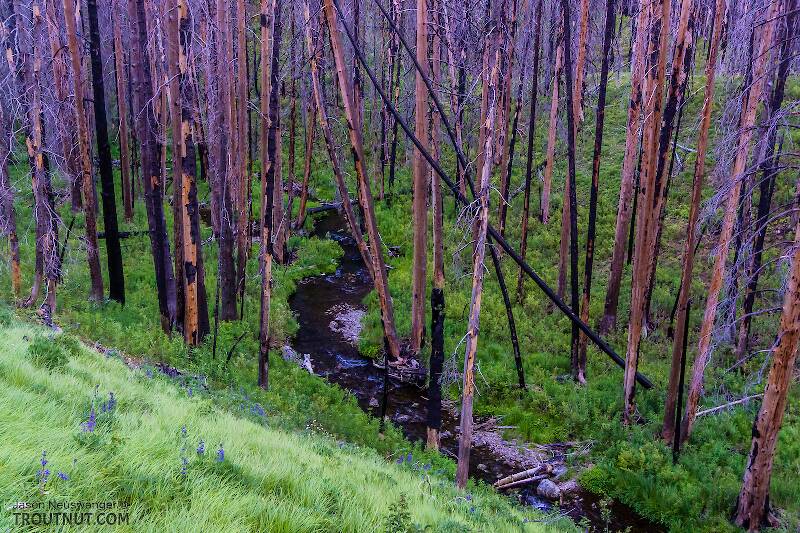
Salmonflies
Pteronarcys californica
The giant Salmonflies of the Western mountains are legendary for their proclivity to elicit consistent dry-fly action and ferocious strikes.


Stonefly Species Megaleuctra williamsae (Tiny Winter Blacks)
Species Range
Identification
Species ID from GBIFthe Global Biodiversity Information Facility
Source: The Genus Megaleuctra Neave (Plecoptera: Leuctridae) In North America
Diagnosis. The male of this species is distinguished from Megaleuctra flinti, the only other eastern North American species, by its differently shaped epiproct. In Megaleuctra williamsae the epiproct is short and consists of a pair of angled processes, which form a groove that encloses the tip of the subanal probe (Figs. 74, 77, 78. 82), while in Megaleuctra flinti it consists of a stout triangular structure that supports the midlength portion of the subanal probe when it is fully extended (Figs. 22, 25, 27) but forms a short wing-like structure when it is located at the base (Figs. 26, 28, 30). Additionally, the subanal probe of Megaleuctra williamsae lacks a median expansion (Figs. 74, 75, 77) whereas in Megaleuctra flinti, it is expanded at midlength (Figs. 22, 25 - 28, 30).
The subgenital plate of the female of Megaleuctra williamsae is subequal in width from beyond the base to almost to the apex (Figs. 83 - 84); whereas in Megaleuctra flinti this structure narrows conspicuously from the base to the apex (Figs. 31, 32). Additionally, the species are allopatric, with Megaleuctra williamsae reaching its most northern range extension in southwestern Virginia, and Megaleuctra flinti reaching its southernmost range extension in northern Virginia.
Physical description
Most physical descriptions on Troutnut are direct or slightly edited quotes from the original scientific sources describing or updating the species, although there may be errors in copying them to this website. Such descriptions aren't always definitive, because species often turn out to be more variable than the original describers observed. In some cases, only a single specimen was described! However, they are useful starting points.
Description from GBIFthe Global Biodiversity Information Facility
Source: The Genus Megaleuctra Neave (Plecoptera: Leuctridae) In North America
Male. Macropterous. Length of forewing 14 - 15 mm; body length 11 - 13 mm. General color light brown. Wings hyaline, with dark stigma occupying more than half the costal space beyond the cord. Radial sector of forewing with two branches. Tergum 9 without large lobe-like processes (Figs. 75, 78); subgenital plate tongue-like, apex slightly emarginated (Figs. 75, 79); vesicle at base sternum 9 short, and narrow (Fig. 75). Tergum 10 without ventrobasal expansion (Fig. 79). Epiproct short, forming a right angle at base in lateral aspect (Figs. 75, 78, 80, 82), broad at base, with middorsal groove and upturned hooks at apex (Figs. 75, 82). Subanal probe very long, cylindrical, directed upward and forward, usually fitting in middorsal groove of epiproct (Figs. 74, 77, 82), apex tapered, slightly truncate at tip (Figs. 75, 81, 82); cerci consist of a greatly elongate single segment (Figs. 75, 77, 78).
Female. Macropterous. Length of forewing 12 - 16 mm; body length 12 - 15 mm. Coloration similar to male. Head oval and somewhat flattened. Pronotum elongate, anterior corners squared off, posterior angles with large inward directed bevels (Fig. 73). Radial sector of forewing with two branches. Sternum 8 formed to an ovipositor-like structure, with subgenital plate extending past tip of abdomen (Figs. 76, 83, 84), broadly rounded from beyond the base to almost the apex (Figs. 76, 83, 84); narrowing to short tip (Fig. 84). Sternum 9 long and very thin (Fig. 84). Cerci inconspicuous (Figs. 76, 83).
Start a Discussion of Megaleuctra williamsae
References
- Jacobus, L. M., Wiersema, N.A., and Webb, J.M. 2014. Identification of Far Northern and Western North American Mayfly Larvae (Insecta: Ephemeroptera), North of Mexico; Version 2. Joint Aquatic Science meeting, Portland, OR. Unpublished workshop manual. 1-176.
Stonefly Species Megaleuctra williamsae (Tiny Winter Blacks)
Species Range
Common Names
Resources
- NatureServe
- Integrated Taxonomic Information System
- Global Biodiversity Information Facility
- Described by Hanson, J.F. (1941) Studies on the Plecoptera of North America, II. Bulletin of the Brooklyn Entomological Society 36, 57–66.

